Translate this page into:
Revision Spine Surgery with Hartshill-Sublaminar Wiring in Operated Osteoporotic Fracture: A Case Note
Address for correspondence: Dr. Pradhyumn Rathi, Department of Spine, Sancheti Institute of Orthopedics and Rehabilitation, Pune - 411 005, Maharashtra, India. E-mail: pradhyumnrathi@gmail.com
-
Received: ,
Accepted: ,
This article was originally published by Wolters Kluwer - Medknow and was migrated to Scientific Scholar after the change of Publisher.
How to cite this article: Hadgaonkar S, Rathi P, Vincent V, Shyam A, Sancheti P. Revision spine surgery with hartshill-sublaminar wiring in operated osteoporotic fracture: A case note. J Orthop Spine 2020;8:118-22.
Abstract
Osteoporotic vertebral compression fractures (OVCF) are one of the most common fractures seen in a day-to-day practice. We present a unique case of failure of pedicle screw instrumentation in OVCF revised by sublaminar wiring (SLW). A 70-year-old female with old operated osteoporotic fracture with the sagittal imbalance and implant loosening was revised with a single spinal rectangular loop and sublaminar wires (SLW). Pedicle screw constructs for short-segment fixation are rigid and biomechanically superior with the greatest pull-out strength, which mainly depends on the bone mineral density. However, sublaminar wires should be considered far more superior in severely osteoporotic bone.
Keywords
Bone density
bone wires
compression
fractures
osteoporosis
pedicle screws
spinal fractures
Introduction
Osteoporotic vertebral compression fractures (OVCF) are one of the most common fractures seen in the day–to-day practice. Indications for the surgery include the presence of neurological symptoms, persisting pain, and deformity. Various modalities of surgical treatment have been described in the form of anterior/posterior instrumented fusion using pedicle screw instrumentation, which is the most popular spinal instrumentation method today.[1,2] In the era of treating osteoporotic spines with dual thread screws, cement augmented screws, or HA-coated pedicle screws, is there a role of the sublaminar wire and Hartshill rectangle in revision surgery with previously operated fracture spine with a loosening of the implant because of severe osteoporosis?
We present a unique case of failure of pedicle screw instrumentation in OVCF revised by sublaminar wiring (SLW). The patient was informed that her data would be submitted for publication, and she has agreed.
Case Report
A 70-year-old female came to the outpatient department with the complaints of back pain and difficulty to sit for prolonged hours. She was unable to stand independently and required support to walk.
She had sustained L1 osteoporotic wedge compression fracture after a trivial fall a year back and was stabilized elsewhere with short-segment pedicle screw instrumentation. Her mid-back pain persisted (visual analog scale [VAS] 7/10, Oswestry disability index [ODI]-74). On giving an adequate conservative trial of medications, her pain worsened, which lead to crouching and inability to stand. On clinical and examination the woman was thin and frail, poorly built with an angular kyphosis at the thoracolumbar junction, which was tender. An X-ray revealed gibbus deformity at L1. A thoracolumbar facet pain block was tried for the patient due to the significant amount of pain, which provided her temporary relief for 3 months after which her pain recurred (VAS 8/10, ODI-80). Her X-ray Figure 1 showed partial backing out of screws and osteolysis around the threads in the vertebral body. Her computed tomography scan Figure 2 showed marginal lysis around the proximal pedicle screws suggestive of implant loosening. Her magnetic resonance imaging [Figure 3] did not reveal any neural compression, as was confirmed by a normal neurological examination, as the canal was decompressed by laminectomy at the index surgery. Her T score was 5.0. Due to significant kyphosis causing sagittal imbalance and implant loosening, she was advised revision surgery in the form of implant removal and fixation with a single spinal rectangular loop and sublaminar wires (SLW).
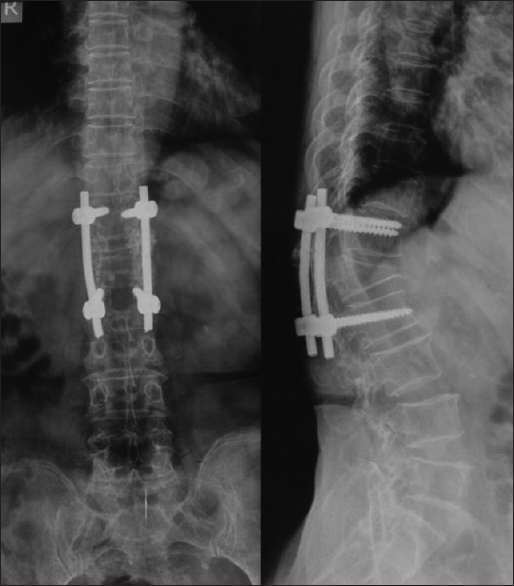
- The X-ray showed partial backing out of screws and osteolysis around the threads in the vertebral body
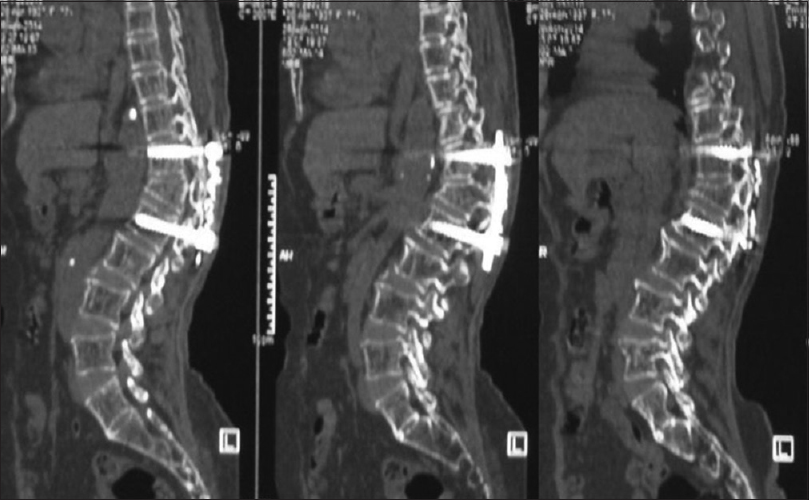
- Computed tomography scan showed marginal lysis around the proximal pedicle screws suggestive of implant loosening

- Magnetic resonance imaging did not reveal any neural compression
Surgical procedure
A midline skin incision extending from 3 levels above to 2 levels below L1 was taken. After midline exposure, paraspinal muscles were elevated and retracted bilaterally from spinous processes, laminae; retracted bilaterally from spinous processes, laminae and pars interarticularis up to the tip of transverse processes at the normal levels. This not only helped in the wide exposure of interlaminar area for wiring but also assisted in preparing a good fusion bed for the bone grafting. Previous implants were removed.
Sublaminar wiring technique
Supra/interspinous ligament and the ligamentum flavum were excised, and a sublaminar space was created at each level for passing wires. After exposing the sublaminar spaces, a double loop of 20G “cold-cured stainless steel wires” were inserted around the laminae of to be instrumented cephalad and caudal vertebral levels by insertion, advancement, roll through, and pull-through technique [Figures 4 and 5]. The measured size loop rectangle is then adequately contoured for sagittal balance [Figure 6]. The wires are passed through the loop rectangle [Figure 7] with cephalad wire always ending inside it, and caudal wire outside the loop rectangle at all levels, except for the terminal ones where the caudal wires end inside the loop rectangle, thus preventing the cephalad or caudal slippage of the loop rectangle. These wires were sequentially tightened clockwise starting at the ends of the loop rectangle followed by inner wires. Tightening the wires in phases until final torque is reached, helps to correct the kyphotic deformity onto the contoured spinal loop rectangle. After the final tightening, the extra length of wire is cut and buried on itself over the lamina. Finally, good graft bed preparation is done for posterior fusion [Figure 8]. Intraoperative blood loss was 300cc, and the surgical procedure was completed in 125 min. Vacuum drain was placed and the wound was closed in layers.[3]
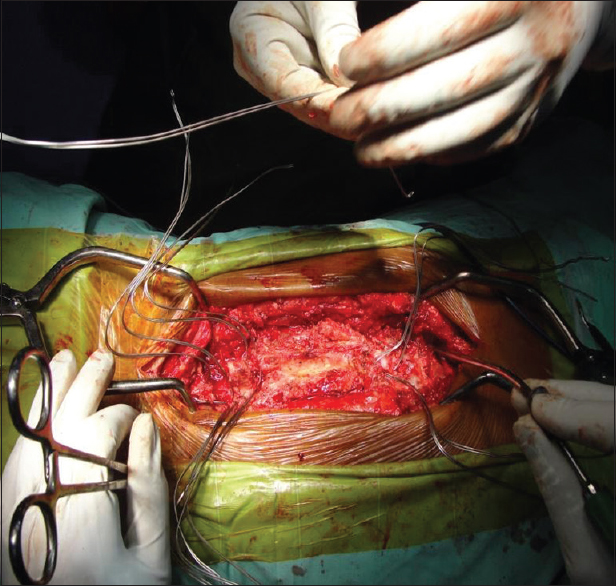
- Sublaminar wiring technique
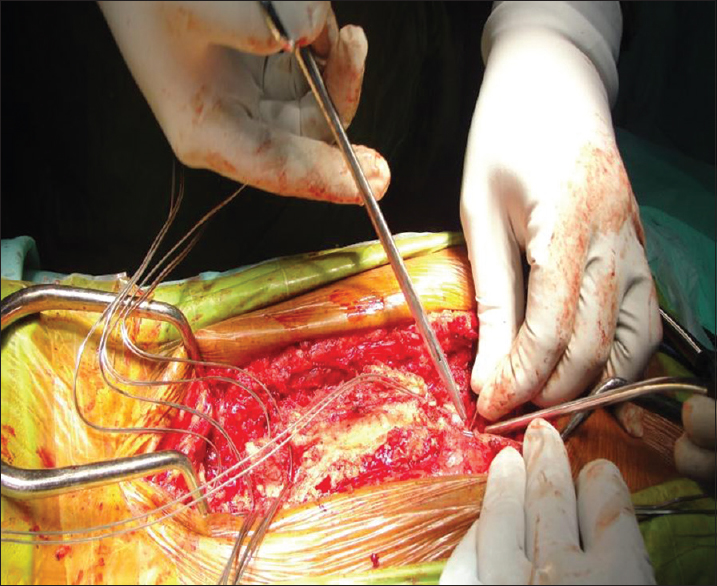
- Sublaminar wiring technique
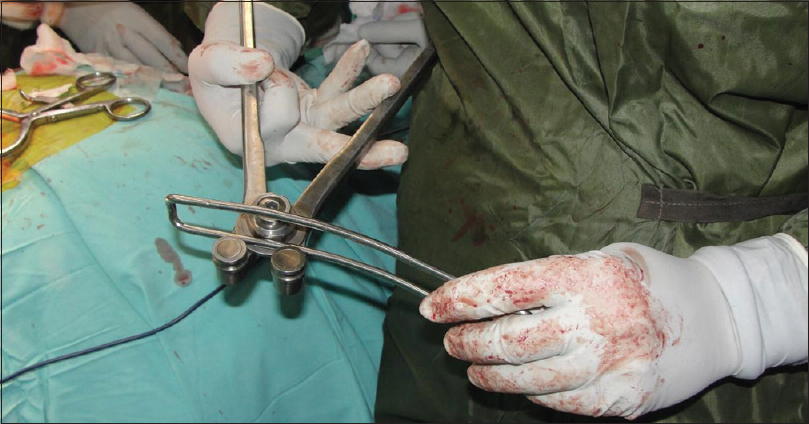
- Sublaminar wiring technique

- Sublaminar wiring technique
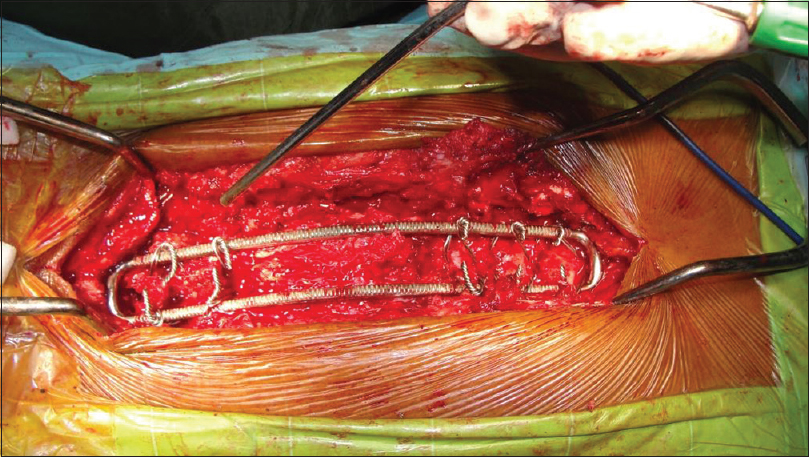
- Good graft bed preparation is done for posterior fusion
Postoperatively, the patient was kept in the high dependency unit (HDU) for monitoring and was shifted back to wards the next day. The vacuum drain was removed after 48 h. No blood transfusions were required, and the patient was hemodynamically stable. In bed exercises and log, rolling began in the HDU and the patient was ambulatory with orthotic support on day 3. The patient was discharged on day 7 on oral analgesics with VAS 7 and ODI 74.
At 6 weeks, her VAS was 4 an ODI improved to 60. The wound had healed, and she was self-ambulatory at home.
At 6 months, Her VAS reduced to 2, ODI was 46, and the patient was doing outdoor ambulation.
After 1 year, the patient had VAS 2/10 and ODI 20. She felt improvement in her sagittal balance while walking and was easily able to sit and stand upright.
At 7 years, the patient had no complaints, but the X-ray revealed improved sagittal balance [Figure 9].
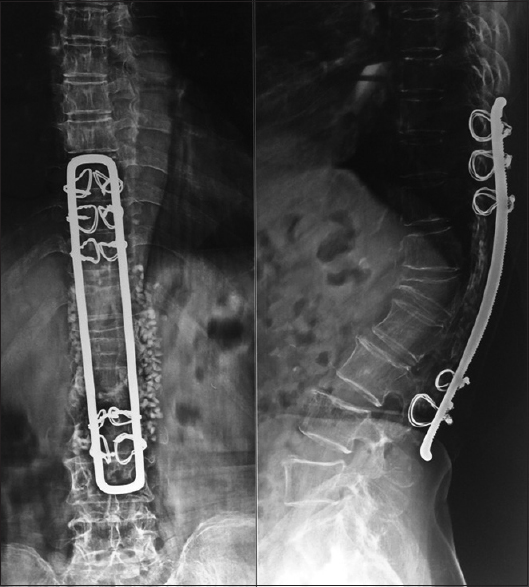
- The X-ray revealed improved sagittal balance breaking of the loop rod
Discussion
With the resurgence of the third-generation spinal implants, the utility of spinal loop rectangle and SLW was considered obsolete.[4] The pedicle screws offer the strongest stabilization and better three-dimensional correction while treating degenerative spine and spinal deformity disorders.[4,5] The use of a pedicle screw rod construct becomes mandatory, especially when interbody fusion is planned in these disorders.
The pull-out strength of the pedicle screws depends on the bone mineral density of the pedicle and vertebral body, which is low in elderly patients with OVCF. The pedicle screws and rod being rigid constructs are at an increased risk of failure by backing out due to anterior column collapse, which occurs with OVCFs. This invariably occurs if the anterior column is not reconstructed.[6,7] Considering the age in whom the OVCFs predominantly occur, anterior approach surgeries are not the preferred one, due to the morbidity and mortality associated with it.[8,9,10,11,12,13]
The newer techniques of augmented pedicle screw fixation require longer learning curves, involve additional costs to the patients, and are not without complications such as failure by posterior displacement while still bound to polymethylmethacrylate[14] or because of detachment from the bone cement, rather than from the posterior displacement of the intact screw–cement mantle construct.[15]
The spinal loop rectangle and SLW is a semi-rigid construct with “cold-cured” dual wires anchored to cortices of both laminae and tightened on to the contoured stainless steel dual rods. In an osteoporotic spine, the cortices of the laminae are much stronger compared to marrow within pedicles as well as vertebral body.[16] Spinal loop rectangle and SLW construct rely on the lamina for its hold, which is the strongest part of the osteoporotic vertebra.
Biomechanically, the spinal loop rectangle and SLW construct only offer sagittal plane stability (by contoured dual rods) and rotational and/or translational stability (by cold-cured dual SLWs, anchored on to the cortices of both laminae, and tightened on to dual rods). Being semirigid and poor in axial stability, this construct allows vertebral collapse to happen (in the absence of anterior column reconstruction).[17,18] This weakness in the construct is utilized to the surgeons advantage by converting anteroinferior dislodgment forces acting at the site of fracture into the forces of fracture union by controlled collapse [Figure 9].
A semirigid, extracortical fracture stabilization by spinal loop rectangle and sublaminar wiring (SLW) is strong enough to hold the spine in normal alignment and also allows controlled axial, anterior column collapse.[19]
Cadaveric spines instrumented with wire and cable display equivalent mechanical behavior, statically and under cyclic loading. The potential advantages of cable, however, must be balanced against a substantial increase in cost relative to wire.[20] Locally made spinal loop rectangle and cold-cured SLW is approximately one-tenth of the price compared to imported third-generation titanium implants (i.e., pedicle screws and rods).
The instrumentation procedure is easy to learn, user friendly, and safer technique. This requires lesser inventory, making it suitable for wider social applicability.
The wound complications related to the longer surgical exposure for extra bony anchor points in the spinal loop rectangle and SLW instrumentation is irrelevant in this patient of OVCF.
Conclusion
The major challenge in open surgical treatment in previously operated osteoporotic fracture is poor fixation in osteoporotic bone. Pedicle screw constructs for short-segment fixation is rigid and biomechanically superior with the greatest pull-out strength, which mainly depends on bone mineral density. However, sublaminar wires should be considered far more superior in severely osteoporotic bone. Restoration of sagittal alignment and avoidance of extra correction can be managed by sublaminar wiring. They are very cost-effective for patients from low socioeconomic strata undergoing a revision spine surgery. The natural history of an OVCF healing (i.e., collapse) and semi-rigid nature of this construct which allows controlled axial collapse to happen, both work in the favor of patient and surgeon's benefit.
Declaration of patient consent
The authors certify that they have obtained all appropriate patient consent forms. In the form the patient(s) has/have given his/her/their consent for his/her/their images and other clinical information to be reported in the journal. The patients understand that their names and initials will not be published and due efforts will be made to conceal their identity, but anonymity cannot be guaranteed.
Financial support and sponsorship
Nil.
Conflicts of interest
There are no conflicts of interest.
References
- Cotrel-dubousset pedicle screw system for various spinal disorders. Merits and problems. Spine (Phila Pa 1976). 1991;16:1298-304.
- [CrossRef] [PubMed] [Google Scholar]
- A historical cohort study of pedicle screw fixation in thoracic, lumbar, and sacral spinal fusion. Spine. 1994;19(20 Suppl):2279S-96.
- [CrossRef] [PubMed] [Google Scholar]
- Safety and efficacy of spinal loop rectangle and sublaminar wires for osteoporotic vertebral compression fracture fixation. Asian J Neurosurg. 2017;12:436-40.
- [CrossRef] [PubMed] [Google Scholar]
- Postoperative neurological deficits in segmental spinal instrumentation. A study using spinal cord monitoring. J Bone Joint Surg Am. 1984;66:1178-87.
- [CrossRef] [PubMed] [Google Scholar]
- Restoration of pedicle screw fixation with an in situ setting calcium phosphate cement. Spine (Phila Pa 1976). 1997;22:1696-705.
- [CrossRef] [PubMed] [Google Scholar]
- Adult spinal deformity in the osteoporotic spine: Options and pitfalls. Instr Course Lect. 2003;52:579-88.
- [Google Scholar]
- Predictors of kyphotic deformity in osteoporotic vertebral compression fractures: A radiological study. Eur Spine J. 2014;23:2737-42.
- [CrossRef] [PubMed] [Google Scholar]
- Apical lordosating osteotomy and minimal segment fixation for the treatment of thoracic or thoracolumbar osteoporotic kyphosis. Spine (Phila Pa 1976). 2005;30:1674-81.
- [CrossRef] [PubMed] [Google Scholar]
- The surgical and medical perioperative complications of anterior spinal fusion surgery in the thoracic and lumbar spine in adults. A review of 1223 procedures. Spine (Phila Pa 1976). 1995;20:1592-9.
- [CrossRef] [PubMed] [Google Scholar]
- Splenic injury complicating the anterior thoracoabdominal surgical approach for scoliosis. A report of two cases. J Bone Joint Surg Am. 1983;65:396-7.
- [CrossRef] [Google Scholar]
- Complications of anterior approaches to the thoracolumbar spine. Emphasis on Kaneda instrumentation. Clin Orthop Relat Res. 1994:110-9.
- [Google Scholar]
- Chylothorax - A rare complication after anterior and posterior spinal correction. Report on six cases. Spine (Phila Pa 1976). 1986;11:830-3.
- [CrossRef] [PubMed] [Google Scholar]
- Prevalence of perioperative complications after anterior spinal fusion for patients with idiopathic scoliosis. J Spinal Disord. 1997;10:371-5.
- [CrossRef] [PubMed] [Google Scholar]
- Revision of cannulated and perforated cement-augmented pedicle screws: A biomechanical study in human cadavers. Spine (Phila Pa 1976). 2010;35:E932-9.
- [CrossRef] [PubMed] [Google Scholar]
- Failure of cement-augmented pedicle screws in the osteoporotic spine: A case report. Geriatr Orthop Surg Rehabil. 2013;4:84-8.
- [CrossRef] [PubMed] [Google Scholar]
- Influence of bone mineral density on the fixation of thoracolumbar implants. A comparative study of transpedicular screws, laminar hooks, and spinous process wires. Spine (Phila Pa 1976). 1990;15:902-7.
- [CrossRef] [PubMed] [Google Scholar]
- History of surgery for the correction of spinal deformity. Neurosurg Focus. 2003;14:e1.
- [CrossRef] [PubMed] [Google Scholar]
- Mechanical stability of the AO internal spinal fixation system compared with that of the Hartshill rectangle and sublaminar wiring in the management of unstable burst fractures of the thoracic and lumbar spine. Spine (Phila Pa 1976). 1998;23:111-5.
- [CrossRef] [PubMed] [Google Scholar]
- The biomechanical analysis of sublaminar wires and cables using luque segmental spinal instrumentation. Spine (Phila Pa 1976). 1997;22:267-73.
- [CrossRef] [PubMed] [Google Scholar]






